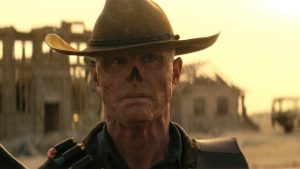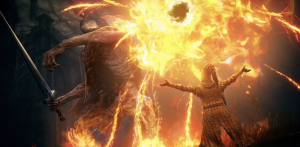“The Avatar Blues.” This semi-tongue-in-cheek term comes from a 2010 CNN article about a startlingly large group of fans who fell into a deep depression after seeing James Cameron’s Avatar in theaters. These people struggled to cope with the reality that they would never be able to actually step foot in the dazzling world of Pandora, with one person sharing this confession on a popular Avatar fan forum: “When I woke up this morning after watching Avatar for the first time yesterday, the world seemed … gray.”
Ubisoft and Massive Entertainment’s Avatar: Frontiers of Pandora, a first-person, open-world adventure set in the same universe as the films, might be the cure these “afflicted” fans have long yearned for. It lets the player explore Pandora’s lush Western Frontier, introducing new characters and a new story that expands on the films’ lore. Ubisoft recently invited Den of Geek to play a preview build of the game on PC ahead of its launch in December. Two and a half hours spent exploring this version of Pandora revealed an engaging, majestic game world that remains true to the source material.
“We really wanted to take players to Pandora,” associate game director Drew Rechner tells Den of Geek. “You can basically imagine that it’s you in this universe from the game’s first-person perspective, which puts you a lot closer to everything in the world.”
To be clear, you don’t need to watch the first two films before jumping into the game (although being able to pick up on all the little callbacks and easter eggs sprinkled throughout the experience will undoubtedly boost your enjoyment). Frontiers of Pandora is a standalone story, though it is canon and takes place shortly before the events of Avatar: The Way of Water. You play as one of a handful of Na’vi who were abducted as children by the RDA, raised and trained to be soldiers as part of the militant corporation’s Ambassador Program, which was abruptly halted in the wake of the Battle of the Hallelujah Mountains at the end of the first film. After being plunged into emergency cryosleep, you awaken 15 years later, free from the grasp of the RDA but faced with the challenge of stopping your former captors from doing further damage to the planet, all while learning about the heritage and culture you’re experiencing for the very first time.
From a gameplay perspective, the hero’s background as a Na’vi plucked from their home only to return as an adult gives the player the opportunity to discover more about the different Na’vi clans and customs through the eyes of a newcomer. The game’s combat and gameplay loops (outpost takeovers, collection quests similar to the Far Cry formula) fold into the plot nicely, which results in a deeper dive into the Na’vi world than even the movies can provide.
“One of the coolest opportunities in making this game was taking the amazing world, cultures, plants, and animals from the films and incorporating them into game mechanics that are fun and stay true to the ethos of Avatar,” Rechner says.
The demo we played included four missions early in the game’s main campaign, centering on the Aranahe clan, a tradition-driven Na’vi tribe led by Ka’nat, who is suspicious of our hero’s history with the RDA. His daughter, Etuwa, enlists us to help get to the bottom of a troubling threat to the tribe, albeit without her father’s consent. Despite our short time with the game, we got a good sense of the characters, and interacting with them in first-person felt cinematic and immersive, the natural camera movements, animations, and highly-detailed character models working in harmony to create a sense of intimacy and proximity the films simply don’t offer. It’s creative decisions like this that justify video game adaptations and help them step out of the shadow of the source material.
It comes as no surprise that Massive’s take on Pandora looks ravishing, but, unexpectedly, the most striking thing about the demo from the moment we jumped in was actually the show-stopping sound design. As we took in the atmosphere of the rainforest around us, we could hear raindrops, tiny insects scuttling up a tree trunk to our left, and there was something lurking in the bushes to our right, its heavy footsteps indicating it was almost certainly a creature of alarming size. We heard all this at once, the soundscape fully enveloping and transportive, giving the experience a tangible sense of space and dimension.
“Everything in the game makes sounds you can hear in 3D space,” Rechner says. “The sound of the rain in the game’s different forests sounds different, and when you have your bow out, you can hear the raindrops hitting the wood, and that sound changes depending on which bow you have equipped.”
Unlike the instantaneously impressive sound design, it takes a moment for the true beauty of the visuals to sink in. Initially, the game does look slick, with the same vibrant colors and bioluminescent flora and fauna that made the films so memorable. But it’s how the whole package comes together and how we, as the player, interact with the game world that makes it so enticing to explore and traverse. The demo was restricted to the Kinglor Forest, one of the game’s three primary regions, and what we saw there looked incredibly detailed.
The heavily forested areas are teeming with life, with each bizarre animal and plant reacting to us in surprising ways. Some creatures are wounded and accept your aid as long as you soothe them as you approach, while others are more hostile to both Na’vi and RDA soldiers. Some plants might shrink away as you approach or spew harmful gas to stave you off. There’s a palpable air of mystery and unpredictability surrounding the wildlife of Pandora that makes the game’s visuals as substantive as they are superficially pleasing.
Gawking at the glowing Kinglor Forest is one thing, but traversing the game world elevates the experience tremendously. Whether you’re running, jumping, swinging on vines, being launched 30 feet into the air by a giant leaf, or soaring through the skies on your dragon-like Ikran, doing barrel rolls to dodge gunfire from RDA drones, all of the movement in the game feels smooth, and at times, exhilarating. The developers chose to go with an unobtrusive UI that encourages you to be observant of the environment around you and travel to locations on the map like a waterfall or a floating mountain not just to complete missions but to simply see if there’s anything interesting to find. The developers’ goal was to ignite curiosity and a sense of wonder in the player. “We want players to take in the game world, and we want discovering Pandora to feel fun in its own right,” Rechner explains.
But beyond the typical video game-y things that most people would expect from this return to Pandora, there is something quite unexpected and special about the game that needs to be highlighted here. The subtext of the main character’s story reflects an experience many immigrants, people of color, and other marginalized people can relate to. In addition to tackling xenophobia just as the films did, the game explores ideas of lost identity, of not feeling accepted in your homeland, and of someone of a mixed background feeling doubly inadequate. Suddenly, the game’s first-person perspective means so much more.
Chella Ramanan, the game’s senior narrative designer, says the team was committed to telling stories that resonate with underrepresented communities: “I really identify with the sense of not being enough of one thing or too much of another,” she says. “When the player attempts to bond with its Ikran, it begs the question, ‘Am I Na’vi enough to do this? What if I get rejected?’”
The team at Massive has designed Avatar: Frontiers of Pandora to be a true expansion of the lore, but it also has something poignant and new to say about both the world of Avatar and our own.
Avatar: Frontiers of Pandora is out on Dec. 7 for Xbox Series X/S, PlayStation 5, and PC.
The post Avatar: Frontiers of Pandora Is the Deepest Dive Into the Avatar Universe Ever appeared first on Den of Geek.









